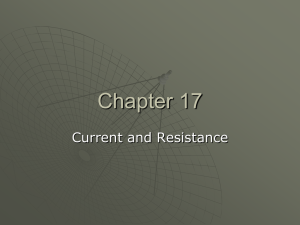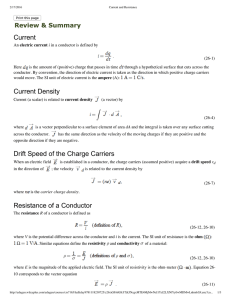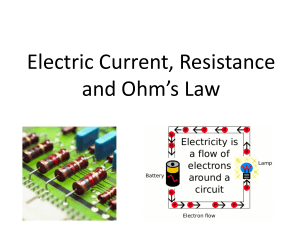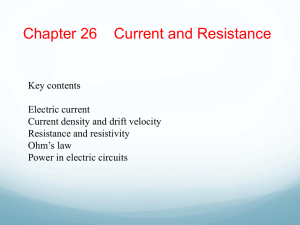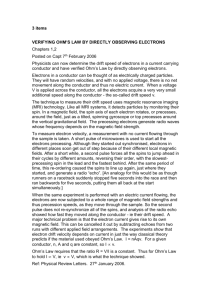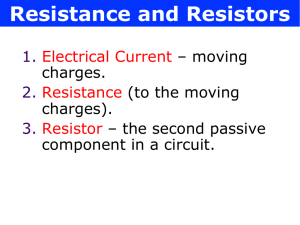Chapter27
advertisement
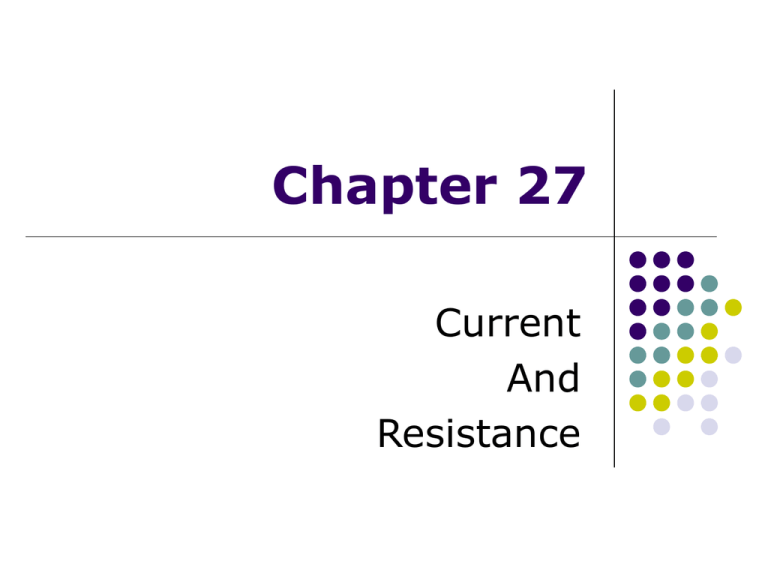
Chapter 27 Current And Resistance 27.1 Electric Current Electric current is the rate of flow of charge through some region of space The SI unit of current is the ampere (A) 1A=1C/s The symbol for electric current is I Average Electric Current Assume charges are moving perpendicular to a surface of area A If Q is the amount of charge that passes through A in time t, then the average current is I avg Q t Instantaneous Electric Current If the rate at which the charge flows varies with time, the instantaneous current, I, can be found dQ I dt Direction of Current The charges passing through the area could be positive or negative or both It is conventional to assign to the current the same direction as the flow of positive charges The direction of current flow is opposite the direction of the flow of electrons It is common to refer to any moving charge as a charge carrier Current and Drift Speed Charged particles move through a conductor of cross-sectional area A n is the number of charge carriers per unit volume nAΔx is the total number of charge carriers Current and Drift Speed, cont The total charge is the number of carriers times the charge per carrier, q The drift speed, vd, is the speed at which the carriers move ΔQ = (nAΔx)q vd = Δx / Δt and x = vd t Rewritten: ΔQ = (nAvd Δt)q Finally, current, Iave = ΔQ/Δt = nqvdA Charge Carrier Motion in a Conductor The zigzag black lines represents the motion of a charge carrier in a conductor The net drift speed is small The sharp changes in direction are due to collisions The net motion of electrons is opposite the direction of the electric field Use the active figure to change the field and observe the effect PLAY ACTIVE FIGURE Motion of Charge Carriers, cont. In the presence of an electric field, in spite of all the collisions, the charge carriers slowly move along the conductor with a drift velocity, vd The electric field exerts forces on the conduction electrons in the wire These forces cause the electrons to move in the wire and create a current Motion of Charge Carriers, final The electrons are already in the wire They respond to the electric field set up by the battery The battery does not supply the electrons, it only establishes the electric field Drift Velocity, Example Assume a copper wire, with one free electron per atom contributed to the current The drift velocity for a 12-gauge copper wire carrying a current of 10.0 A is 2.23 x 10-4 m/s This is a typical order of magnitude for drift velocities 27.2 Resistance Current Density J is the current density of a conductor It is defined as the current per unit area J = I / A = nqvd This expression is valid only if the current density is uniform and A is perpendicular to the direction of the current J has SI units of A/m2 The current density is in the direction of the positive charge carriers Conductivity A current density and an electric field are established in a conductor whenever a potential difference is maintained across the conductor For some materials, the current density is directly proportional to the field The constant of proportionality, σ, is called the conductivity of the conductor Ohm’s Law Ohm’s law states that for many materials, the ratio of the current density to the electric field is a constant σ that is independent of the electric field producing the current Most metals obey Ohm’s law Mathematically, J = σ E Materials that obey Ohm’s law are said to be ohmic Ohm’s Law, cont. Not all materials follow Ohm’s law Materials that do not obey Ohm’s law are said to be nonohmic Ohm’s law is not a fundamental law of nature Ohm’s law is an empirical relationship valid only for certain materials Georg Simon Ohm 1789 -1854 German physicist Formulated idea of resistance Discovered the proportionalities now known as forms of Ohm’s Law Resistance In a conductor, the voltage applied across the ends of the conductor is proportional to the current through the conductor The constant of proportionality is called the resistance of the conductor V R I Resistance, cont. SI units of resistance are ohms (Ω) 1Ω=1V/A Resistance in a circuit arises due to collisions between the electrons carrying the current with the fixed atoms inside the conductor Resistivity The inverse of the conductivity is the resistivity: ρ=1/σ Resistivity has SI units of ohm-meters (Ω . m) Resistance is also related to resistivity: Rρ A Resistor Values Values of resistors are commonly marked by colored bands Resistivity Values Resistance and Resistivity, Summary Every ohmic material has a characteristic resistivity that depends on the properties of the material and on temperature The resistance of a material depends on its geometry and its resistivity Resistivity is a property of substances Resistance is a property of an object An ideal conductor would have zero resistivity An ideal insulator would have infinite resistivity Ohmic Material, Graph An ohmic device The resistance is constant over a wide range of voltages The relationship between current and voltage is linear The slope is related to the resistance Nonohmic Material, Graph Nonohmic materials are those whose resistance changes with voltage or current The current-voltage relationship is nonlinear A junction diode is a common example of a nonohmic device Resistance of a Cable, Example Assume the silicon between the conductors to be concentric elements of thickness dr The resistance of the hollow cylinder of silicon is ρ dR dr 2πrL Resistance of a Cable, Example, cont. The total resistance across the entire thickness is b ρ b R dR ln a 2πL a This is the radial resistance of the cable This is fairly high, which is desirable since you want the current to flow along the cable and not radially out of it



